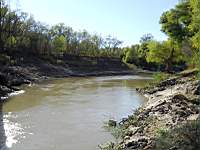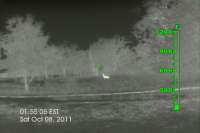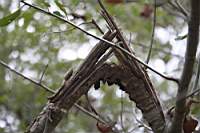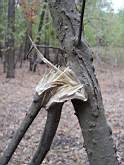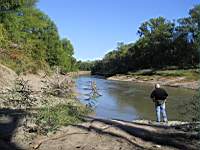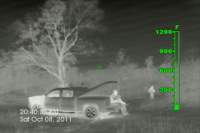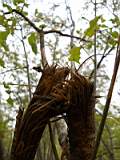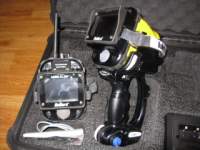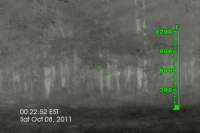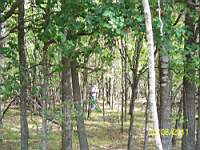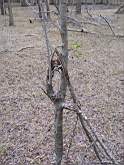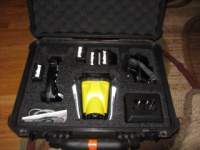October 7/8/9 2011 East Texas outing
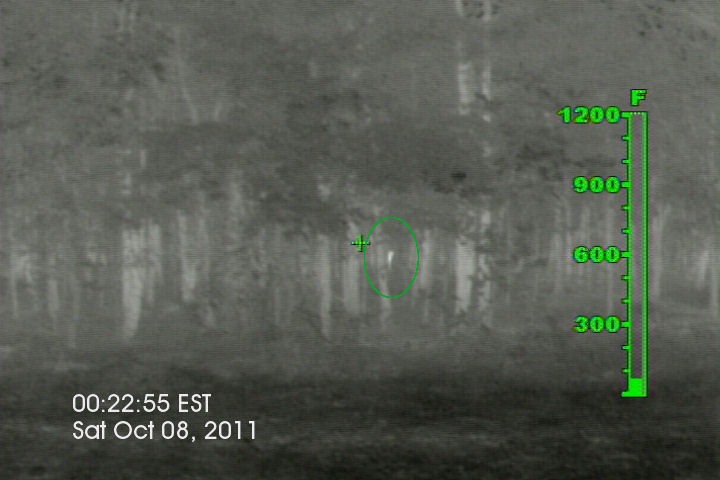 For this outing we had a total of 11 researchers participating, this included all 6 TexLa members 2 members of the Mid-America Bigfoot
Research Center and 3 independents. We arrived at the site around Noon on Friday October 7th. This is a large tract of private property,
with active oil drilling efforts as well as several herds of cattle which seem to have the run of the 3000 acres. The property is bordered
to the West and South by the Trinity River, which has a long history of reported sightings by property owners including some which
we have investigated a few miles south of this location. Day time temps on this weekend reached the low 90's with night time lows in the
mid 70's. We setup our camp in the NW quadrant of the property and began to make plans for the evening. This was the first research
outing where we had the use of a thermal camera. This technology is still quite pricey with entry level low resolution camera's
costing 1-2 thousand dollars. The camera that we used was valued much higher than this and was on loan so needless to say we were
taking great care with it. During the weekend we had an incident that left us with the opinion that a quality thermal camera is an
absolute must for this kind of research effort. We used the camera on ourselves at base camp to gain some idea of the effect of clothing
and how the image contrasted with the uncovered skin on various parts of the body.
For this outing we had a total of 11 researchers participating, this included all 6 TexLa members 2 members of the Mid-America Bigfoot
Research Center and 3 independents. We arrived at the site around Noon on Friday October 7th. This is a large tract of private property,
with active oil drilling efforts as well as several herds of cattle which seem to have the run of the 3000 acres. The property is bordered
to the West and South by the Trinity River, which has a long history of reported sightings by property owners including some which
we have investigated a few miles south of this location. Day time temps on this weekend reached the low 90's with night time lows in the
mid 70's. We setup our camp in the NW quadrant of the property and began to make plans for the evening. This was the first research
outing where we had the use of a thermal camera. This technology is still quite pricey with entry level low resolution camera's
costing 1-2 thousand dollars. The camera that we used was valued much higher than this and was on loan so needless to say we were
taking great care with it. During the weekend we had an incident that left us with the opinion that a quality thermal camera is an
absolute must for this kind of research effort. We used the camera on ourselves at base camp to gain some idea of the effect of clothing
and how the image contrasted with the uncovered skin on various parts of the body.
Friday October 7, 2011
After camp was setup we began to do some scouting in the immediate area and found many tree breaks, we have included a few pictures of these. Most were probably natural but we did find a few that were interesting, due to our hair find in Oklahoma, tree breaks need to be checked as a matter of routine due dilligence as you never know what you will find. For Friday we began our deployment efforts around 4PM, placing game cameras and audio recorders in various locations around the property. By 7PM we had deployed 10 game cameras and around a dozen audio recorders. We planned to use some call blasting, starting at 10:30PM about 1/2 mile West of base camp which placed the call blast team roughly half way between base camp and the river. Two and three man listening teams equipped with parabolic dishes had been deployed to various positions around the property. The first call blast went out at 10:37PM and immdiately produced an interesting response, followed closely thereafter by Coyotes. The initial response was picked up by the Call Blast team on their parabolic and was clearly heard by the listening team sitting in base camp, from what was heard we were fairly convinced that we had something of interest. Later in the evening, the audio captured on the Digital 8 Camcorder was reviewed and all agreed that it sounded like a throaty, raspy attempt to copy the call. The next day audio captured on one of our dropboxes of this same event was compared to the Camcorder recording. The value of having multiple recorders paid off in that we were able to identify the response as coming from one of the resident Coyotes. Copies of both recordings are provided below, this illustrates both the tendency of Coyotes to mimic what they hear as well as the problem that Coyotes represent when attempting to separate the known from the unknown vocalist.
At 11:30PM the call blast team moved to a second more centrally located position from which to setup a second round of calls. This produced only some distant Coyote responses. At 12:10AM the call blast team along with the two listening teams deployed off the road South of base camp began their return to camp. The vehicle with the thermal camera led the way as they slowly proceded along the road heading North. At 12:22AM a thermal hit was aquired along the East side of the road and is described in detail below by the camera operator:
"On Saturday 10-8-11 @ 0022hrs while returning to camp I had the thermal imager resting on the truck door with the window down (thermal imagers can not see through glass) to scan the woods for any heat signatures as we drove. I was scanning out to a 2 o'clock position as this gave me a better viewing angle and to give ample time to stop if something was seen. We were approaching a slight curve but still on a straight section of road when I noticed a very large heat signature on the TI (Thermal Imager). Still not sure what I was looking at I told the driver to slow down that I had a thermal hit, as he proceeded to brake, I pressed the record button on the TI to begin what I thought was the video. (As I would find out later I did not press the video record button long enough to record but long enough to capture 2 still images of the subject.) The driver backed up to an area where I could get an unobstructed view...After we stopped I asked the driver if he could see on the TI viewing screen what I was looking at, he stated yes..... what we watched appeared to be bipedal in nature. (In the course of the night we had seen deer, cattle and other wildlife....this DID NOT match any of those heat signatures). For almost 1 minute you could clearly see what appeared to be a bipedal figure standing straight up beside a tree as if to hide, (I had the impression it was looking over its right shoulder toward the road at us) you could see the shoulders and head....as the other vehicles came to a stop...we watched through the TI as the subject then turned to its left, ducked down about 1/4 of its height and exited to the ENE very rapidly. It was at this point I lost it on the TI.... I exited the vehicle and continued to scan the tree line in the general direction of travel the subject may have left. Seeing nothing else and talking to the other team members I had a member walk in to the woods where the subject was standing, his heat signature was no where near the subjects, the members heat signature was very subdued and mottled due to clothing...he also did not appear to be as big as the subject and appeared several inches shorter. The members shoulders did not appear as broad as the subject we saw. The one thing that impressed myself and my driver was how fluid and fast the subject was. It is hard to describe in writing how fast and effortlessly it moved. There was no jerky motion, no hesitation....just smooth. After talking to the team we decided to return to camp let things calm down and return an hour later to see if anything else could be seen or to see if the subject would return. On the return trip only cows and deer were seen. We returned to camp around 0300hrs."
"Returning later Saturday morning we measured the distance to the subject from the truck location using one of the thermal stills to line up the trees so we could gather distance and height information as well as look for evidence that may have been left behind. We measured the distance to the subject with a laser range finder at 45yards. We also found a possible reason for the subject to have to duck as it turned, as there was very large vine hanging down at around the 5 1/2 foot mark. We were unable to find any physical evidence, but we were able to find a large game trail that was in the direction the subject left, which would have aided in said subject vacating the area. Several lessons were learned with this thermal imager, the record button has to pressed and held for 3 seconds to get video and objects/subjects are farther away then they appear."
In addition to all of this that was happening around the time that we began our return to camp at 12:15AM there was a possible wood knock, that was picked up by several of our recorders. The knock event turned out to be closest to the point where the cars had been parked near an out of service Pump Jack. This audio is included below, we have several copies of it and have notated the distance that each was from the Pump Jack area (some picked it up at over 1000 yards) so that the reader can see that this knock event was not caused by one of the vehicles, etc. as we left the area. The knock was not heard by any of the researchers as we had all entered our vehicles by the time it occurred. Again this shows the value of leaving audio recorders out after a research team has vacated an area as it answers many questions regarding what happened after you left.
After returning to base camp and discussing the thermal hit at some length, several team members jumped into one of the trucks and returned to the roads where the first thermal hit took place. Many animals where clearly visible to the thermal camera including, cows, deer and coyotes. No additional sightings of anything bipedal was witnessed by the team on this run so we returned to camp around 3AM.
Saturday October 8, 2011
On Saturday our plans included revisiting the thermal hit location as discussed above to determine things such as distance to the subject, height of the subject and to look for any physical evidence at the scene. We would also be making a sweep to collect all audio recorders for download. Time permitting we were going to do a targeted review of some of the audio from the previous night since we had an audio event at a known time, this was the aforementioned Coyote vocal. We also spent some additional time scouting for any possible Sasquatch sign that we might have missed the day before.
Additional information that can be shared regarding the thermal hit from Friday night is that the height of the subject was at least 3-4 inches taller than the researcher standing in for the creature, this would set the height of the subject in the 6'5"-6'7" range. The subject was totally white when viewed by the 2 witnesses on the thermal camera, this can be seen from the still photo at the top of this report. It is representative of the heat signature that the entire body exhibited. This makes a human target unlikely (unless a tall human was running around naked) as our testing with the camera on ourselves clearly showed that clothes hang off the body at various distances and as such some parts of the clothing are several degrees cooler than those areas closer to the skin, thus giving the person a strange mottled look with only the uncovered skin showing up brightly.
For Saturday night we planned to spread out the listening teams a bit more with one team spending several hours along the river, one person was left to listen around base camp, and the rest where divided into a Road Run team and a Call Blast team. After a several calls were tried at the first location, resulting in only Coyote responses, the Road Run team was dispatched to a location at the South end of the property. This was to give them a chance to scan the roads along the way to see if they would pick up a second interesting hit. Once there they held station while the Call blast team relocated, once the call blast team arrived at their location they setup and proceeded to send out several calls. No responses were detected for this second round of calls and in fact after reviewing the audio from Saturday night nothing unidentified vocalized in that area after we left either. Having no luck the Road Run team was called back to lead the way to base camp. The River Team did have several strange incidents including something jumping into the river and then stomping its way back out. A deer on the opposite bank blew and stomped for several minutes around this time as well.
Some observations from this outing and information regarding the thermal camera that we were using. Road running is about the oldest research technique in existance and its effectiveness is not very good even if you have a 3rd Gen night vision scope, but with thermal its a whole new ball game. Road running is going to be much more effective going forward, if you are dedicated to this area of research a Thermal camera is going to be a must have. We are excited to say that we will have the use of a couple thermal units on future outings going forward so watch this space. The thermal camera that we used on this trip was a model "T320" made by "Bullard". We have provided a couple of pictures of this unit below, it was provided to us with separate wireless viewing monitor which was handy as it allows other people in the vehicle to see what the camera is seeing in real time. There was also a handle attachement that provides a secure hand grip as well as providing the recording media such that you can capture both stills and video. It was only our unfamiliarity with the device due to this being our first time to use it that caused us to miss a chance at video of this incident, however, we expect to make good on opportunities in the coming months. Below we have posted a couple of sample video's produced on the camera we were using this weekend.
